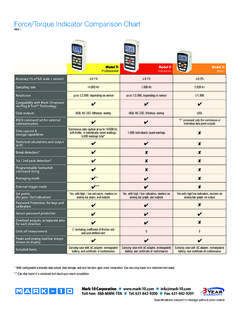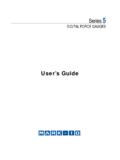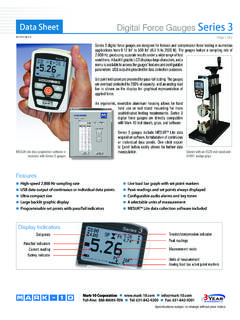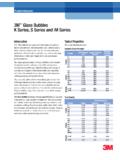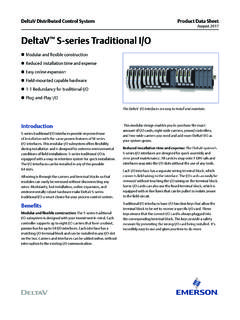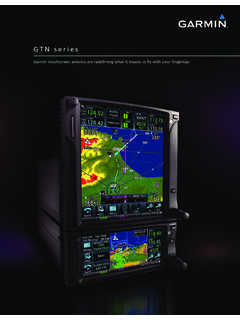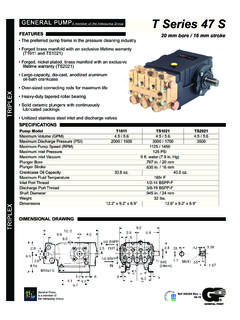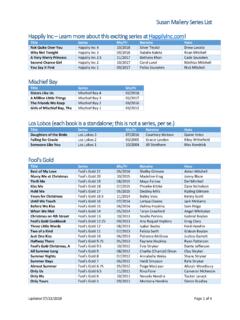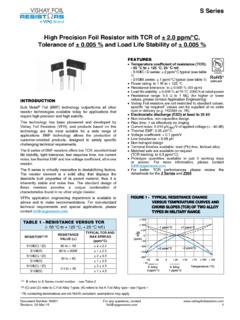Transcription of Series 4 User's Guide - Mark-10 Force Measurement
1 Series 4. DIGITAL Force GAUGES. User's Guide Series 4 Digital Force Gauges User's Guide Thank you . Thank you for purchasing a Mark-10 Series 4 digital Force gauge, designed for tension and compression Force testing applications from lb to 500 lb ( N to 2,500 N) full scale. The Series 4 is an essential component of a Force testing system, typically also comprising a test stand, grips, and data collection software. With proper usage, we are confident that you will get many years of great service with this product. Mark-10 Force gauges are ruggedly built for many years of service in laboratory and industrial environments. This User's Guide provides setup, safety, and operation instructions. Dimensions and specifications are also provided. For additional information or answers to your questions, please do not hesitate to contact us. Our technical support and engineering teams are eager to assist you.
2 Before use, each person who is to use the Series 4 Force gauge should be fully trained in appropriate operation and safety procedures. TABLE OF CONTENTS. OVERVIEW ..2. POWER ..3. SETUP ..4. HOME SCREEN AND CONTROLS ..6. OPERATING DIGITAL FILTERS ..8. SET POINTS ..9. DATA MEMORY AND STATISTICS ..10. COMMUNICATIONS AND OUTPUTS ..12. CALIBRATION ..15. OTHER SPECIFICATIONS ..22. 1. Series 4 Digital Force Gauges User's Guide 1 OVERVIEW. List of included items Part No. M4-012 M4-50 M4-200 . Qty. M4-20 M4-100 M4-500 Description 1 12-1049 12-1049 12-1049 Carrying Case 1 AC1030 / AC1030 / AC1030 / AC adapter body with US, EU, or UK prong AC1031 / AC1031 / AC1031 /. AC1032 AC1032 AC1032. 1 08-1026 08-1026 08-1026 Battery (inside the gauge). 1 G1024 G1024 G1031 Extension rod 1 G1026 G1026 G1033 Cone 1 G1025 G1025 G1032 Chisel 1 G1027 G1027 G1034 V-groove 1 G1029 G1029 G1036 Flat 1 G1028 G1038 G1035 Hook 1 N/A G1039 G1037 Coupling 1 - Certificate of calibration 1 09-1165 USB cable 1 - Resource CD (USB driver, User's guides, MESUR Lite software, MESUR gauge DEMO.)
3 Software, User's Guide ). Safety / Proper Usage Caution! Note the Force gauge's capacity before use and ensure that the capacity is not exceeded. Producing a Force greater than 200% of the gauge's capacity can damage the internal load cell. An overload can occur whether the gauge is powered on or off. Typical materials suitable for testing include many manufactured items, such as springs, electronic components, fasteners, caps, films, mechanical assemblies, and many others. Items that should not be used with the gauge include potentially flammable substances or products, items that can shatter in an unsafe manner, and any other components that can present an exceedingly hazardous situation when acted upon by a Force . The following safety checks and procedures should be performed before and during operation: 1. Never operate the gauge if there is any visible damage to the AC adapter or the gauge itself.
4 2. Ensure that the gauge is kept away from water or any other electrically conductive liquids at all times. 3. The gauge should be serviced by a trained technician only. AC power must be disconnected and the gauge must be powered off before the housing is opened. 4. Always consider the characteristics of the sample being tested before initiating a test. A risk assessment should be carried out beforehand to ensure that all safety measures have been addressed and implemented. 5. Wear eye and face protection when testing, especially when testing brittle samples that have the potential to shatter under Force . Be aware of the dangers posed by potential energy that can 2. Series 4 Digital Force Gauges User's Guide accumulate in the sample during testing. Extra bodily protection should be worn if a destructive failure of a test sample is possible. 6. In certain applications, such as the testing of brittle samples that can shatter, or other applications that could lead to a hazardous situation, it is strongly recommended that a machine guarding system be employed to protect the operator and others in the vicinity from shards or debris.
5 7. When the gauge is not in use, ensure that the power is turned off. 2 POWER. The gauge is powered either by an NiMH rechargeable battery or by an AC adapter. Since the batteries are subject to self discharge, it may be necessary to recharge the unit after a prolonged period of storage. Plug the accompanying charger into the AC outlet and insert the charger plug into the receptacle on the gauge (refer to the illustration below). The battery will fully charge in approximately 8. hours. USB connector Power input jack Serial connector Caution! Do not use chargers or batteries other than supplied or instrument damage may occur. If the AC adapter is plugged in, an icon appears in the lower left corner of the display, as follows: If the AC adapter is not plugged in, battery power drainage is denoted in a five-step process: 1. When battery life is greater than 75%, the following indicator is present: 2.
6 When battery life is between 50% and 75%, the following indicator is present: 3. When battery life is between 25% and 50%, the following indicator is present: 4. When battery life is less than 25%, the following indicator is present: 5. When battery life drops to approximately 2%, the indicator from step 4 will be flashing. Several minutes after (timing depends on usage and whether the backlight is turned on or off), a message appears, BATTERY VOLTAGE TOO LOW. POWERING OFF . An audio tone will sound and the gauge will power off. The gauge can be configured to automatically power off following a period of inactivity. Refer to the Other Settings section for details. If battery replacement is necessary, it can be accessed by separating the two halves of the gauge. Refer to the Setup section for details. 3. Series 4 Digital Force Gauges User's Guide 3 SETUP. Mechanical Setup Loading shaft orientation In order to accommodate a variety of testing requirements, the orientation of the loading shaft may be set up in either of the two positions shown below.
7 In order to change the loading shaft orientation, loosen the two captive screws on the back side of the housing, separate the two housing halves, rotate one half 180. degrees, and reassemble. Contact between the two halves is made by spring pins and contact pads on the printed circuit boards. Load cell shaft up Load cell shaft down Mounting to a plate Proper mounting is important if attached to a fixture or test stand. The round steel insert with a hole in the back of the housing is provided to withstand the load during a test. A mating dowel pin should be used (see illustration below). Mounting plates on Mark-10 test stands include a dowel pin and clearance holes for the four threaded holes located near the corners of the housing. These holes are designed to accommodate screws in order to hold the gauge in place ( Mark-10 test stands include a set of thumb screws for gauge mounting).
8 The screws must not be used for load bearing purposes. Failure to use a dowel pin properly can result in a hazardous situation. Mounting attachments to the gauge The Force gauge's threaded loading shaft is designed to accommodate common grips and attachments with female mounting holes. To mount a grip, gently thread it onto the shaft. Ensure that the grip or fixture is positioned to ensure axial load with respect to the loading shaft of the Force gauge. When using a grip, 4. Series 4 Digital Force Gauges User's Guide ensure that it secures the sample in such a way that it is prevented from slipping out during a test, preventing a potential safety risk to the operator and others in the vicinity. If using a grip or fixture from a supplier other than Mark-10 , ensure that it is constructed of suitably rugged materials and components. Do not use jam nuts or tools to tighten grips or attachments onto the shaft.
9 Finger-tighten only. Installing the USB driver If communicating via USB, install the USB driver provided on the Resource CD. Installation instructions may also be found on the CD or may be downloaded from Caution! Install the USB driver before physically connecting the gauge to a PC with the USB cable. Further instructions for configuring and using the gauge's outputs are provided in the Communications and Outputs section. 5. Series 4 Digital Force Gauges User's Guide 4 HOME SCREEN AND CONTROLS. Home Screen 1. 10 2. 9 3. 8. 4. 7 6 5. No. Name Description 1 Tension /. compression - indicates a compression (push) direction indicator - indicates a tension (pull) direction These indicators are used throughout the display and menu. 2 Peaks The maximum compression and tension readings. These readings are reset by pressing ZERO or by powering the gauge off and on.
10 3 Primary reading The current displayed Force reading. See Operating Modes section for details. 4 Load bar Analog indicator to help identify when an overload condition is imminent. The bar increases either to the right or to the left from the midpoint of the graph. Increasing to the right indicates compression load, increasing to the left indicates tension load. If set points are enabled, triangular markers are displayed for visual convenience. This indicator reflects the actual load, which may not correspond to the primary reading (depends on operating mode). The ZERO key does not reset the load bar. See Operating Modes section for details. 5 Units The current unit of Measurement . Abbreviations are as follows: lbF Pound- Force ozF Ounce- Force kgF Kilogram- Force gF Gram- Force N Newton kN Kilonewton mN Millinewton Note: not all gauge capacities measure in all the above units.




